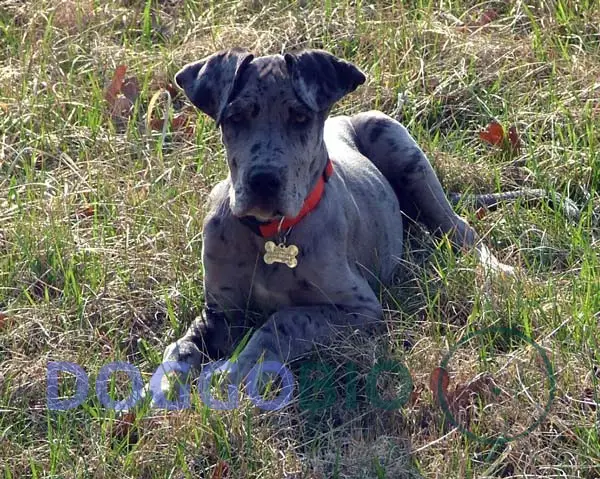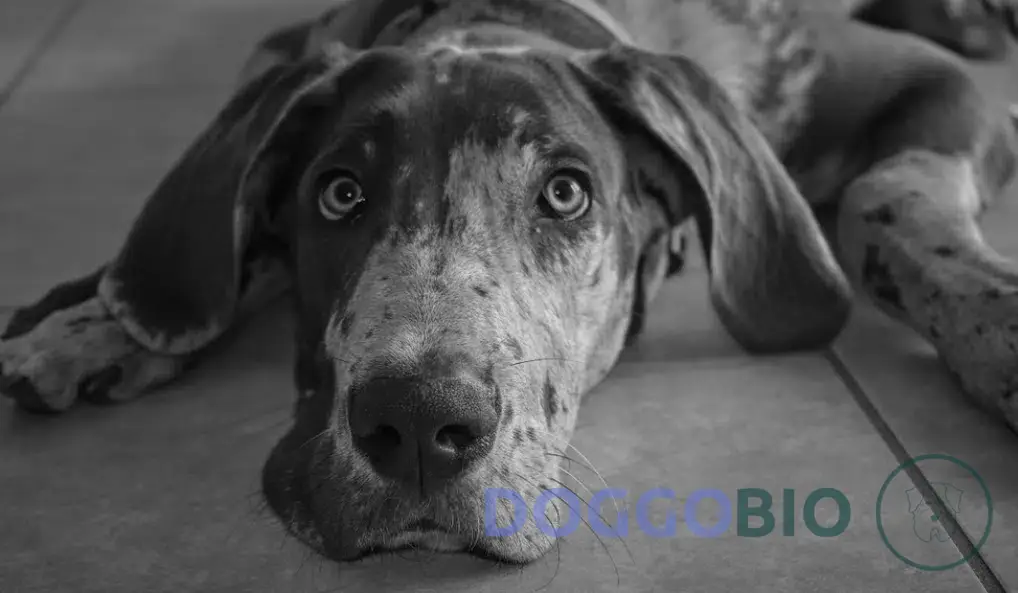The Blue Merle Great Dane, often regarded as a majestic and captivating canine breed, stands out for its stunning and distinctive coat pattern that combines various shades of blue and gray. With its remarkable size and regal appearance, the Blue Merle Great Dane commands attention wherever it goes.
In this article, we will delve into the fascinating world of this breed, exploring its history, unique characteristics, temperament, and the care it requires to thrive as a beloved member of your family. Whether you’re a seasoned Great Dane enthusiast or simply intrigued by these magnificent dogs, join us on a journey to discover the captivating allure of the Blue Merle Great Dane.
A Brief Overview of Great Dane Blue Merle
| Breed Name | Blue Merle Dane |
| Purity | Purebred |
| Purpose | Companion dog |
| AKC Recognition | No |
| Size | Large |
| Weight | 110 – 175 pounds |
| Height | 28 – 34 inches |
| Coat Colors | Gray, Black |
| Child Friendliness | High |
| Canine Friendliness | Moderate |
| Training Difficulty | Low – Moderate |
| Grooming Upkeep | Low |
| Exercise Needs | Low – Moderate |
| Lifespan | 7 – 10 years |
| Puppy Costs | $1,000 – $2,500 |
What is Blue Merle Great Dane?

The Blue Merle Great Dane is a captivating variation of the breed. These dogs have a striking light silver base coat and diluted black torn patches spread across their body. They are sometimes called dilute merles, representing a unique variation within the realm of Merle Great Danes.
How to Get Merle Genes?
Breeding Great Danes in colors beyond harlequin can lead to mesmerizing Merle coat patterns. When a fawn or brindle Dane has a parent carrying the merle gene, “fawn” Merles can emerge, featuring a cream base with dark specks. Those with robust brindle genes may have broken stripes blending into the coat, resembling spots.
Blue Merle Great Danes flaunt slate-blue hues with black spotting, emphasizing the importance of their bluish-black nose pigmentation. This unique trait sets them apart and justifies their “blue” name, even if they exhibit diluted pigmentation in some areas.
Ethical Controversies in Genetics
While we admire the perfection and beauty of Merle Great Danes, it’s crucial to address potential challenges in breeding them. Breeding merles can result in issues like stillborn or sick puppies and increased risk of future health problems. Specifically, “double merle” puppies may suffer from stillbirth, blindness, deafness, and genetic abnormalities.
Our stance aligns with the Great Dane Club of America’s Breeder’s Code of Ethics, which deems breeding Merle Great Danes unethical due to the risks outweighing potential benefits.
To ensure your beloved Merle Great Dane’s well-being, consider neutering or spaying them. This decision promotes a longer and healthier life for your cherished companion.
What Does a Blue Merle Great Dane Look Like?
Despite not having official recognition, Blue Merle Great Danes remain purebred with typical physical traits.
- These dogs boast a large size, showcasing well-balanced, muscular, and smooth bodies. Males exhibit a square shape, while females may have slightly longer bodies.
- Their heads are elongated and finely chiseled, with square jaws.
- Almond-shaped eyes are common, sometimes featuring blue eyes due to the Merle gene, but brown eyes can also occur.
- They sport a bluish-black nose with occasional black spotting.
- Their medium-sized ears are naturally floppy, although some opt for erect ears in proportion to the head’s size.

Size, height, and Weight
Blue Merle Great Danes are celebrated for their imposing size. Typically, they reach their ideal height around 18 months of age, developing a sturdy chest by two years. Both males and females go through a significant growth spurt between 4 to 6 months of age. Generally, females are lighter and may stand an inch or two shorter than their male counterparts.
| Height | Weight | |
| Male | 30 – 34 inches | 140 – 175 pounds |
| Female | 28 – 32 inches | 110 – 140 pounds |
Temperament and Personality
The Great Dane, often hailed as the “Apollo of dogs,” boasts a calm and gentle nature despite its imposing size. They thrive in the company of their family and may experience separation anxiety if left alone for extended periods.
Great Danes excel as guard dogs, thanks to their loyalty and watchful demeanor. They stay vigilant and will protect their loved ones when needed.
Blue Merle Great Danes make fantastic additions to families experienced with larger breeds. However, first-time dog owners may find their care challenging due to their size and unique health considerations.
They are generally great with children but require supervision during play to prevent accidental bumps.
When introduced to other pets early on, Great Danes can form positive relationships, but they might show aggression towards unfamiliar animals.
Training and Exercise Requirements
Blue Merle Great Danes are generally obedient and eager to please, making training relatively straightforward with patience and consistency. Given their size, early socialization and obedience training are crucial. Exposure to various people and situations helps them adapt well.

They need a minimum of 2 hours of daily exercise, best split into two brisk walks or hikes. Be cautious with puppies under two years, avoiding vigorous runs to protect their joints. Providing a spacious backyard for play and light running is beneficial for their health and fitness.
Grooming and Cleaning
- Despite their short hair, Blue Merle Great Danes’ large size can lead to loose hair issues if not managed. To control shedding, brush them twice a week with a medium slicker brush, bristle brush, or hound glove, as their single coat is easy to maintain.
- Expect more shedding during spring, so invest in a powerful vacuum cleaner like Miele to control fur and dander.
- Bathe them once or twice a month with gentle, pH-balanced, organic dog shampoo to avoid stripping natural oils. Use doggie wipes for quick cleanups between baths.
- Maintain dental hygiene by brushing their teeth daily or 3 to 4 times a week using enzymatic dog toothpaste.
- Regularly check their ears to prevent infections and trim their nails with a dog nail grinder for comfort and precision.
Food and Diet
An adult Blue Merle Great Dane typically requires a daily intake of 2,500 to 3,000 calories, equivalent to 6 to 10 cups of food.
It is advised to divide their meals into 2 to 3 portions to prevent bloating, and strenuous exercise should be avoided immediately after eating.
A diet containing no more than 24% protein and 12% to 14% fats is considered optimal for their nutritional needs.
Life Expectancy and Common Health Issues
On average, Blue Merle Great Danes have a lifespan of 7 to 10 years. Blue Merle Great Dane puppies are susceptible to the same health problems as other Merle Great Danes. The severity of these health issues may be heightened for Blue Merle individuals.

Potential health concerns for Blue Merle Great Dane puppies include:
- Stillbirth
- Blindness
- Deafness
- Skin problems
- Behavioral issues, such as aggression
Furthermore, Blue Merle Great Danes may carry defective genetic material, contributing to their susceptibility to various health problems.
How Much is a Blue Merle Great Dane?
The cost of Blue Merle Great Dane puppies can vary. Prices typically start at $1,000 and can range up to $2,500.
List of dogs that are similar to Blue Merle Great Dane
Frequently Asked Questions
Are Blue Merle Great Danes Rare?
No, Blue Merle Great Danes are not rare. The perception of rarity arises due to their lower frequency, largely because they haven’t gained official recognition within the breed standards. However, this doesn’t diminish their value or unique appeal as a variation of the Great Dane breed.
Does AKC recognize Blue Merle Great Dane?
No, Blue Merle is not recognized as an accepted color for Great Danes by the American Kennel Club (AKC). Consequently, Blue Merle Great Danes are ineligible to participate in the club’s confirmation shows.
How do I know if my puppy is blue Merle?
To determine if a Great Dane is a Blue Merle, you can look at the color of its nose. The presence of a blue nose serves as the distinguishing feature of a Blue Merle Great Dane.
Are Blue Merle Great Danes hypoallergenic?
No, Blue Merle Great Danes are not hypoallergenic. They shed consistently throughout the year and experience heavier shedding during spring.
However, their short hair makes it easier to manage by regular brushing and diligent vacuuming to minimize hair spreading throughout the house.
Conclusion
In conclusion, the Blue Merle Great Dane embodies a harmonious blend of beauty, grace, and gentle nature. Their captivating coat pattern and imposing presence are a sight to behold. Their loyal and affectionate temperament makes them ideal family pets, capable of bringing immense joy and comfort to their loved ones.
The Blue Merle Great Dane is a breed that leaves a lasting impression, leaving an indelible mark on the hearts of those fortunate enough to share their lives.

Pingback: Great Dane Chihuahua Mix: A Guide to Unique Hybrids 2024
Pingback: Great Pyrenees Great Dane Mix: Majestic Canine Blend 2024
Pingback: Great Dane Boxer Mix: Dynamic Duo Unleashed 2024